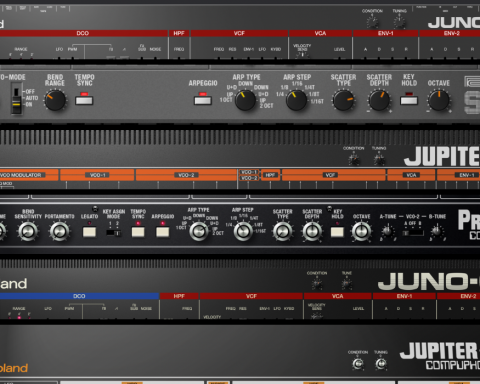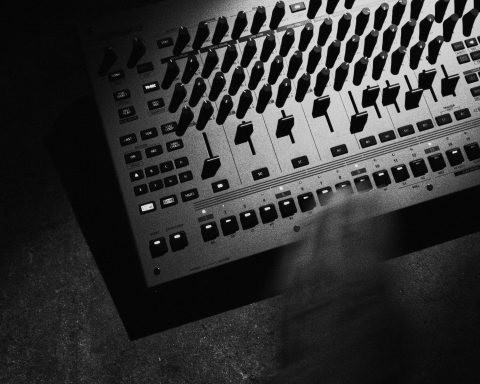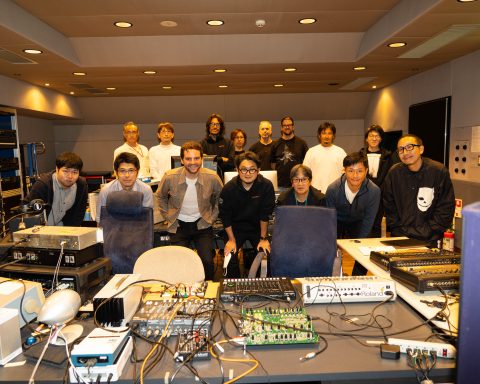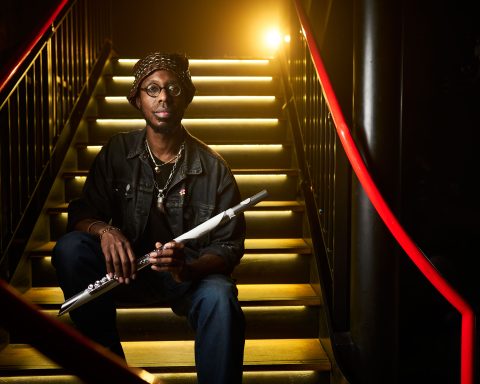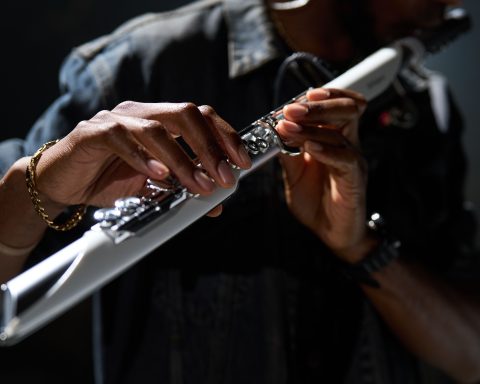Few modern electronic musical instruments have had as wide and deep an impact as the TR-808. Not just on music, either. Of course, the 808 has been used in hundreds, if not thousands, of records as a beat machine. But it has had more of an effect than this. Like a pebble thrown into a pond, the ripples that started upon the drum machine’s release have expanded ever outwards. The 808 influenced not only the rhythms of popular songs but also helped launch entirely new genres and, most importantly, changed what bass, in general, can be.
The Beat
The 808’s influence on music started small. Upon its release in 1980, it found favor with a number of forward-thinking musicians and producers, like Trevor Horn, who used it not just as a rhythm machine but also as a trigger. While it faced stiff competition from the LM-2 LinnDrum, the drum machine of choice for pop producers, the 808 was soon discovered by a new generation of young musicians actively creating their own genre: hip-hop.
Afrika Bambaataa famously used the 808 on “Planet Rock.” Combined with icy strings and Soul Sonic’s Force’s unusual rapping style, it sounded like the future. Whereas pop producers liked the LinnDrum because it sounded like real drums, the sheer “electronicness” of the 808 drew in hip-hop producers. The machine didn’t sound like anything else on earth, which was precisely what they wanted for their music. “Planet Rock” was a hit and set the blueprint for a style of hip-hop that would become known as electro, which continues to this day with 808-style beats still the foundation of the genre.
"The machine didn’t sound like anything else on earth, which was precisely what producers wanted for their music."
Changing the Mix
It seems standard now, but having a kick drum that could go low into subfrequencies was revolutionary in 1980. For one, it didn’t sound anything like a real drum. The closest thing might be an Odaiko drum, but that’s still a stretch. Also, no vinyl record and very few sound systems could reproduce the kind of low frequencies the 808 was capable of. However, because of its popularity with hip-hop producers, records and sound systems were forced to evolve.
One of the first records to truly capture the power of the 808 was “Egypt Egypt” by Los Angeles producer Egyptian Lover. He worked with the record mastering engineer to create a 12” single that was deep and loud enough to reproduce the 808’s low kicks cleanly and with power. (Interestingly, Egyptian Lover also recorded the 808’s trigger sound and used it as part of his drums in his records.)
Elevating the Bass
By the late 1980s, hip-hop producers had started moving away from electro-style jams and were incorporating sampling more and more. Using sampling drum machines like the MPC60 and SP-1200, they could capture bits from old soul and funk records to make new songs. However, the 808 was still a part of hip-hop at this point, with producers in New York like Marley Marl using sampled 808 kicks to bolster the beat and add low end.
Meanwhile, in Florida, producers created their own genre, freestyle. This mix of hip-hop, electro, and Latin-style pop was popular with DJs in roller skating rinks, a common way for young people to hear music in America in the 1980s.
"By the late 1980s, hip-hop producers had started moving away from electro-style jams and were incorporating sampling more and more."
A New Dynamic
Enter Dynamix II. As roller skating rink DJs, the duo knew what local people wanted and began making records to play in their sets. Like the New York producers, they primarily used an SP-1200, although they relied more on 808 sounds than funk samples. Their 1987 record, “Just Give The DJ A Break,” changed everything, however, because of the novel way they used 808s.
Inspired by a hip-hop record that used a low synthesizer funk bassline over an 808 rhythm, Dynamix II combined a TR-909 kick with the boom portion of an 808 kick to make a sound that could be both the kick and a chromatic bassline. “We took inspiration for the tuning of the 808 kick from a track by Sweet T & Jazzy Joyce called ‘It’s My Beat,'” David Noller says. They put the two sounds together, transferred it to a sampler, and played it chromatically using the instrument’s multi-pitch mode. The 808 bass was born.
"Dynamix II combined a TR-909 kick with the boom portion of an 808 kick to make a sound that could be both the kick and a chromatic bassline."
Bass Ripples and Samplers
“Just Give The DJ A Break” and its pitched 808 basslines seismically affected popular music. The song started a new genre, called bass music, that exploded locally in Miami and then spread to the rest of the country through artists like 2 Live Crew. It inspired young people to customize the stereos in their cars for maximum bass. Many even began competing to see who could get the loudest and deepest bass—all powered by 808 booms.
Some producers may have used actual TR-808 machines. Still, most were employing sampled 808 drum sounds. By putting the sounds into samplers like the SP-1200, which had 12-bits and 26.040 kHz resolution, the booms gained all kinds of artifacts, grit, and distortion. Early samplers like the S612 and S900 were similarly 12-bit. Producers were probably sharing samples as well, compounding artifacts. This cumulative effect is often integral to the sound of the 808 basses, helping audibility on smaller sound systems. Modern producers use saturation and bit reduction techniques to achieve a similar effect.
"Producers started making their own 808-style bass sounds, although in a primitive manner compared to current techniques."
808 Experiments
Around this time, producers started trying to create their own 808-style bass sounds, although in a primitive manner. They called these bass tones 808s even though they weren’t created with the TR-808. The earliest examples came from mixing board test tones and, later, sampler test tones. To create the rhythm track for LL Cool J’s “Mama Said Knock You Out,” hip-hop producer Marley Marl made 808-style sounds with 30Hz and 40Hz test tones from mixing desks by using a real TR-808 to trigger a gate on the test tone. These were not pitched, however, and functioned more as percussion than basslines.
In The Jungle
Around 1990, a new sound of music began to emerge in the UK. First called hardcore and then jungle, it combined fast hip-hop breaks with 808 sub bass. Rather than use the 808 as a kick, they used programming techniques to turn long samples of 808 booms into basslines. One trick they used was to smooth out the attack, removing the transient but retaining the body of the sound.
Jungle producers preferred rackmount samplers. As with hip-hop producers and the SP-1200, this added a layer of grit and punch to their 808 sounds.
"Jungle producers preferred rackmount samplers. As with hip-hop producers and the SP-1200, this added a layer of grit and punch to their 808 sounds."
Jungle is back in fashion, and modern artists are taking inspiration from its mix of fast breakbeats and 808s. The popular DJ duo Disclosure recently released the jungle track “Higher Than Ever Before,” although its 808 bassline comes from a soft synth, not actual 808 samples.
IDM and the R-8
Another machine that made an impact is the Roland’s R-8. Most bedroom electronic music producers couldn’t afford a real 808, even in the early ’90s, but they could get an R-8. It was popular with the influential Aphex Twin, and was the source of the 808 sounds on his early records. Many modern producers looking for a ’90s IDM sound will use the R-8 for its 808 sounds.
"Building on the Dynamix II approach, Southern producers used 808 kick samples and—increasingly often—their synthesizers to make 808-style sounds to use as basslines."
It’s A Trap
In America, hip-hop began to abandon sampling and return to 808 sounds. This evolution was particularly apparent in the southern part of the country in states like Texas and Georgia. Building on the Dynamix II approach, these producers used 808 kick samples and—increasingly often—their synthesizers to make 808-style sounds to use as basslines. Outkast and Lil Wayne, two of the most prominent Southern hip-hop artists of the 2000s, utilized this technique.
Now called trap, the genre exploded from hip-hop in the 2010s to include numerous electronic styles, from ambient to more aggressive styles. All feature the 808 bass as an integral element. YouTube is full of how-to videos explaining the best way to program an 808-style bass sound by processing samples or synthesizing one yourself.
Another increasingly widespread hip-hop genre is drill, which started in Chicago and spread to the UK and throughout the US. While similar to trap, drill retains its unique sonic features. Still, the 808’s characteristic thump powers drill beats.
The TR-808 Today
Unlike the limited choices available to producers of the past, modern music makers have powerful options for authentic 808 sounds from the source. Available through Roland Cloud, the TR-808 Software Rhythm Composer is a lovingly engineered replica of the original with some clever enhancements. In addition, the ZENOLOGY Software Synthesizer has an easy-to-use pitched 808 patch.
On the hardware front, the TR-8S and TR-6S have a chromatic bass mode, which allows users to get hands-on with their bassline creation. Whether you choose software, hardware, or both, these instruments capture the fabled 808 boom in all its speaker-shaking glory.


